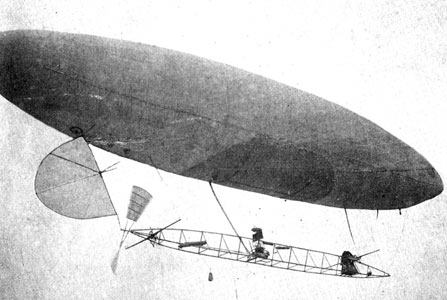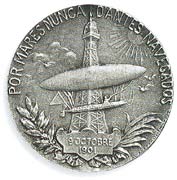

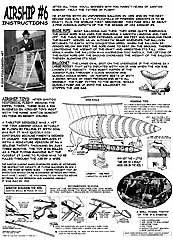
Alberto Santos DuMont and his airship-Downloadable cardmodel
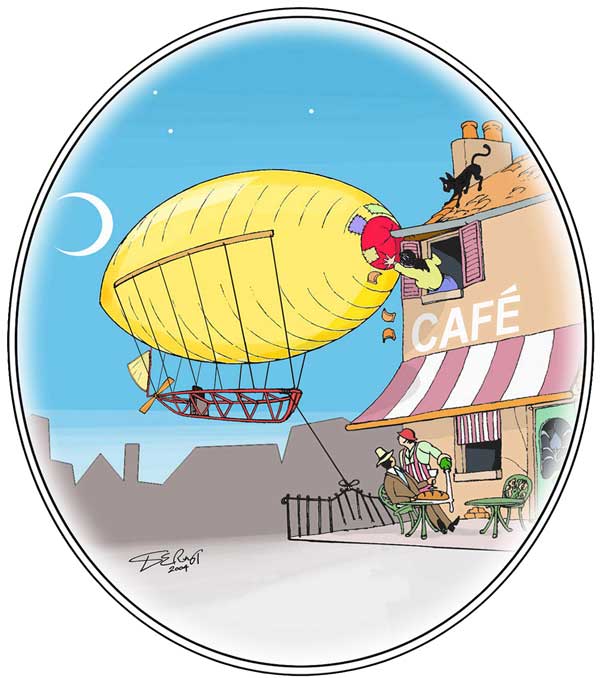
This original artwork by Derek Roberts is available in much higher quality (suitable for framing), on the Full Collection DVD.
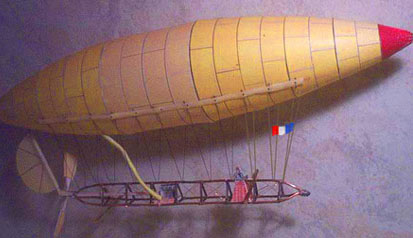
Alberto
Santos-Dumont,
The young plantation owner from Brazil, spent lavishly in building sausage-shaped
airships, establishing the first airport, and maintaining a fleet of dirigibles.
His first flight was made in 1898 in a cylindrical balloon 80 feet long and
propelled by a small gasoline engine suspended in a car below. Releasing gas
to make a landing, he averted a catastrophe by signaling a group of boys to
pull his collapsing dirigible like a kite by its guide rope as it neared the
ground.
After two failures he succeeded, in 1901, in circling the Eiffel Tower in Paris despite a strong wind, and won the de la Meurthe 100,000 francs. award for his achievement. For a decade he continued to be a central figure in French aviation, performing a series of spectacular feats with air-ships, and later airplanes, and proving by his accomplishments the practicality of flying.
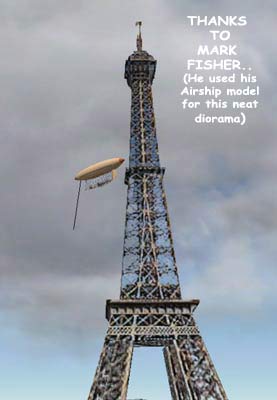 Personal
Airship! Joe (from the paper modelers group)
Personal
Airship! Joe (from the paper modelers group)
I finally finished your Dumont Airship, and thought you might like to see a picture of it (). The rigging was, to put it nicely, challenging. The final result is very nice, however, and the picture helps cover up my self-created blemishes. Instead of using wire for the gondola, I simply cut out the paper version, then cut out the panels and added what detail I could. I stopped short of trying to put the bracing wires on the gondola sides...it was just too much! :-) I probably could have done better, but my kids seem to think its impressive. Well, I guess its onto the next model for me. Keep up the great work! The more you offer, the more I build, and the better modeler I become!... talk to ya later,tim
Another fine and unusual model from Fiddlers Green. Great art that can give any level of modeler a satisfying result.
This is a really good-looking model when completed. It begs to be hung for full appreciation. My plan is to custom build a shadow box with silhouetted buildings (including the French landmarks) and non descript buildings in the bottom to display it. Maybe with glass on both sides.
Of all the balloons FG has published this is my favorite. It has a Jules Verne/Edgar Rice Burroughs look to it yet it actually existed. Good build, nice pieces and gave me the opportunity (again) to try some techniques I had never used before. Can't go wrong for the price. Jim Golden- writer : Check out Jim's complete Airship revue at: http://www.tinpaper.net/airship_6.html
Dear Fiddler's Green Staff Members: I just got from PMI Paper Models International your NORGE and your Santos-Dumont Airship No. 6 and they are very beautiful kits indeed. I will start work on the Norge shortly and it will be a lot of fun. I hope you would consider doing other airships in the same scale and I can share information with you. Alain
I had a lot of questions from friends on procedure to rig Dumont's Airship # 6. Rigging the airship is a TOUGH job unless you use a jig and a weight in the keel. Insert a headless 3" nail in the triangular keel. When it is weighted, the threads are easier to handle and the tension in the threads will be maintained. A music wire keeps the keel parallel to the gas bag and keeps the proper distance while rigging. Don't forget to make a foamcore or balsa jig to hang up and stabilize the gas bag... you need to have your 2 hands free in order to mend the threads with precision. Here is a little drawing.(see below) Hope you are all in good health.... amitiés de Quebec, Jacques
Sorry to interrupt your busy day but thought I would drop a fact on you that you might or might not know. Albert being as small as he was usually had his hands full trying to manage his balloons. As such he had to find a way to keep track of time while flying. Pocket watches didn't do the job. Awkward, not exactly hands free, and easily dropped. His solution, and one adopted by all the fashionable people who followed his every move in Paris, was to attach a pocket watch to a wristband. Randy Guenin.
Santos Dumont and his personal Airship #6

Santos- Dumont caught
the imagination of the aviation minded world when,
in his 110-ft airship Number 6, he flew from St Cloud to and around the
Eiffel Tower and back on 19 October 1901.
Flying in a DuMont Airship....
(An account by Santos)
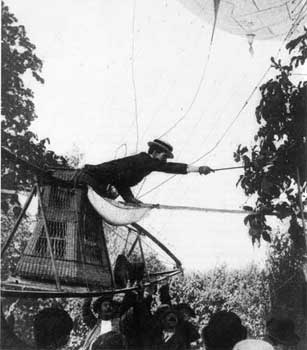 'At 11 am all was ready. The basket rocked prettily beneath
the balloon, which a mild, fresh breeze was caressing. Impatient to be
off, I stood in my corner of the narrow wicker basket with a bag of ballast
in my hand. In the other corner M. Machuron gave the word: "Let go, all
!"
'At 11 am all was ready. The basket rocked prettily beneath
the balloon, which a mild, fresh breeze was caressing. Impatient to be
off, I stood in my corner of the narrow wicker basket with a bag of ballast
in my hand. In the other corner M. Machuron gave the word: "Let go, all
!"
'Suddenly the wind ceased. The air seemed motionless around us. We were off, going at the speed of the air current in which we now lived and moved. Indeed, for us there was no more wind; and this is the first great fact of all in spherical ballooning. Infinitely gentle is this unfelt movement forward and upward. The illusion is complete: it seems not to be the balloon that moves, but the earth that sinks down and away.'
Any man who could write so vividly and observantly about his first ascent in a balloon was clearly an enthusiast, and Alberto Santos-Dumont, who wrote those lines, was not only an enthusiast himself but one whose exploits aroused the interest of others. News of his romantic adventures, and especially of his hair raising escapes from disaster, was awaited throughout the world with the kind of eagerness that is aroused today by international film stars and footballers. Alberto had 'personality', as well as being a great pioneer of aviation.
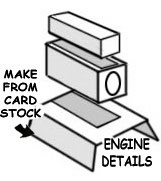 Nature made Santos-Dumont a very small, slim, slight man,
weighing hardly more than one hundred pounds, but very active and muscular.
He was in the Crystal Palace, London, where he was setting up one of his
airships in a huge gallery, looking like, at first glance to be some boy,
a possible spectator, who was interested in flying machines. His face,
bare
and shaven, looked youthful; he wore a narrow brimmed straw hat and was
dressed in the height of fashion. . . . A moment later he had his coat
off and was showing his men how to put up the great fan-like rudder of
the ship which loomed above us like a giant.
Nature made Santos-Dumont a very small, slim, slight man,
weighing hardly more than one hundred pounds, but very active and muscular.
He was in the Crystal Palace, London, where he was setting up one of his
airships in a huge gallery, looking like, at first glance to be some boy,
a possible spectator, who was interested in flying machines. His face,
bare
and shaven, looked youthful; he wore a narrow brimmed straw hat and was
dressed in the height of fashion. . . . A moment later he had his coat
off and was showing his men how to put up the great fan-like rudder of
the ship which loomed above us like a giant.
He was living in Paris, though he has been a frequent visitor to England and America. He speaks Spanish, French, and English with equal fluency. One finds him most unpretentious, modest, speaking freely of his inventions.
As a child, Santos-Dumont had been inspired by the stories of Jules Verne, and from his tenth year he was driving railway engines on his father's plantation. During his schooling in Paris he familiarized himself with all aspects of ballooning and made his first ascent in 1897. He enjoyed the experience so much that he had a balloon made for himself.
After one ascent from *Nice he made a crash-landing which he once recalled led in these words:
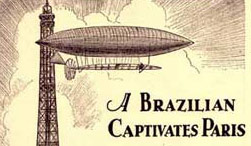 'I was dragged
through the small trees and yielding shrubbery, my face a mass of cuts
and bruises, my clothes torn from my back, in pain and strain, fearing
the worst, and able to do nothing to save myself. Just as I had given
myself up for lost the guide-rope wound itself round a tree and held.
I was precipitated from the basket and fell unconscious. When I came to
I had to walk some distance until I met some peasants. They helped me
back to Nice, where I went to bed, and had the doctor sew me up".
'I was dragged
through the small trees and yielding shrubbery, my face a mass of cuts
and bruises, my clothes torn from my back, in pain and strain, fearing
the worst, and able to do nothing to save myself. Just as I had given
myself up for lost the guide-rope wound itself round a tree and held.
I was precipitated from the basket and fell unconscious. When I came to
I had to walk some distance until I met some peasants. They helped me
back to Nice, where I went to bed, and had the doctor sew me up".
Trees were to loom very large in the life of the young Br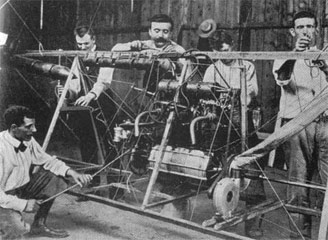 azilian.
In 1898 his first steerable airship came to grief. Two days later, on
descent, the repaired envelope began to crumple in the middle, but some
boys seized the guide rope and dragged the airship against the wind, checking
the descent. The second airship was dashed against trees and wrecked.
The third lost its rudder and was damaged. To save weight in the fourth,
Alberto sat on a bicycle saddle. The fifth had further tree-trouble, and
Alberto was found in the branches, where he had lunch sent up to him.
He was next discovered by firemen hanging in space above a courtyard of
the Trocadero Hotel.
azilian.
In 1898 his first steerable airship came to grief. Two days later, on
descent, the repaired envelope began to crumple in the middle, but some
boys seized the guide rope and dragged the airship against the wind, checking
the descent. The second airship was dashed against trees and wrecked.
The third lost its rudder and was damaged. To save weight in the fourth,
Alberto sat on a bicycle saddle. The fifth had further tree-trouble, and
Alberto was found in the branches, where he had lunch sent up to him.
He was next discovered by firemen hanging in space above a courtyard of
the Trocadero Hotel.
Combining ingenuity and courage with wealth, Alberto Santos-Dumont scored victory after victory in the conquest of the air when the cause of aeronautics seemed a losing one.
In quest of knowledge about the work of airship inventor, Giffard, the young plantation owner from Brazil spent lavishly in building sausage-shaped airships, establishing the first airport, and maintaining a fleet. of dirigibles. His first flight was made in 1898 in a cylindrical balloon 80 feet long and propelled by a small gasoline engine suspended in a car below. Releasing gas to make a landing, he averted a catastrophe by signaling a group of boys to pull his collapsing dirigible like a kite by its guide rope as it neared the ground.
After two failures he succeeded, in 1901, in circling the Eiffel Tower in Paris despite a strong wind, and won the de la Meurthe award for his achievement. For a decade he continued to be a central figure in French aviation, performing a series of spectacular feats with air-ships, and later airplanes, and proving by his accomplishments the practicality of flying.
The Santos-Dumont series of airships..
Alberto Santos-Dumont, the small Brazilian dandy, was without
any doubt one of the most colorful figures in the long gallery of aeronautical
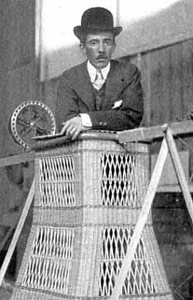 pioneers.
His family wealth sprang from South American coffee plantations, but he
himself lived and worked most of the time in and around Paris. He footed
the bill for more than a dozen small airships, most of which were his
own creations. All of them were powered by petrol engines.
pioneers.
His family wealth sprang from South American coffee plantations, but he
himself lived and worked most of the time in and around Paris. He footed
the bill for more than a dozen small airships, most of which were his
own creations. All of them were powered by petrol engines.
Santos-Dumont was born in 1891 and left his native country at the age of 18, heading for an education in the French capital where the newfangled automobiles and ballooning caught his fancy. Following his first ascent, in a balloon belonging to the French aeronaut Alexis Machuron, he built one for his personal use. It was of 3,990 cu.ft capacity and named Brazil, but his interest inclined towards the elongated airship variety and he hit up-on the sensible idea of picking one of the light and efficient Dion-Bouton automobile engines as his power plant. The outcome was Santos Dumont's 'No. I', which was 82 ft long, with a maximum diameter of 11.5 ft, and had a gas content of 6,360 cu.ft. It made its first trial run on 18 September 1898 from the new zoological garden in Paris, Jardin d'Acclimatation, but it was only of short duration as the airship ended up in a tree.
The result of the next flight was somewhat better, but neither 'No. 1 nor its successor, the slightly larger 'No.2' of 1899, was particularly successful. The failure was mainly due to the lack of an amply rigid keel, and thus the airship envelope was not sufficiently rigid in either case; and also, Santos-Dumont still stuck to the balloon arrangement of suspending the gondola by ropes. With his 'No, 3' airship he managed to cross Paris by air and circle the Eiffel Tower, which encouraged him to take up airship construction in earnest. To this end he had a large shed erected on land at Saint-Cloud outside Paris, which the French Aero Club had just acquired. There he had a workshop built as well, and installed equipment for the production of hydrogen, but in addition he had a branch connection laid to the main pipes of the public gasworks, as he planned on using coal gas to provide the lift for his future airships.
The Santos-Dumont airships 'No.4' and 'No.5' were produced during the winter of 1900-01. They constituted improved designs with more powerful engines and were both fitted with reinforced keels accommodating the pilot.
The many aerial jaunts of Santos Dumont with his various airships were often risky affairs and seldom lacked sensation, He seemed to lead a charmed life and a fortune-teller foretold that he would die in his bed in the end. Once his engine caught fire in the air, but he coolly put it out by smothering the first thin flames with his straw hat. On another occasion his airship collapsed and dropped on to the roof of a house in the center of the French capital; the firemen were called out, who soon rescued him and brought him, unharmed, down one of their tall escape ladders.
Those were the days before any air traffic control or other safety restrictions! Santos-Dumont could do much as he pleased, for he was the darling of the city, and it appealed to the Parisians to glance skyward and see him come skimming along their boulevards at roof level and then perhaps to park his 'steed' while leisurely enjoying his luncheon at one of the fashionable outdoor restaurants. The acme of Santos-Dumont's air career, and his most outstanding airship achievement, was winning the 100,000 francs Deutsch award by accomplishing the stipulated air performance in circling the Eiffel Tower. The money had been put up in 1900 by the French petroleum magnate Henri Deutsch de la Meurthe, to go to the first to leave Saint-Cloud by air and return to that starting point within 30 minutes after rounding the Eiffel Tower, under official supervision.
The distance to be covered totaled 6.8 miles and so called
for a speed of slightly more than 15.5 mph Santos-Dumont failed on his
first 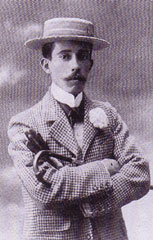 attempt
with 'No.5', but succeeded with his new and improved airship 'No.6'. He
took off on 19 October 1901 at 2:42 p.m. There was a slight crosswind
blowing, but he made directly for his turning point and rounded the lightning
conductor on top of the slender lattice-work at a distance of 165 ft while
checking that only nine minutes of his allowed time had then been spent.
The wind was less favorable on the return trip and the engine also started
misfiring. Santos-Dumont quickly decided to let go of his controls for
a moment while attempting to adjust the engine, but meanwhile also took
the risk that the airship might run off course, His gamble paid off and
he crossed the final control point in Saint-Cloud with 29 seconds to spare.
attempt
with 'No.5', but succeeded with his new and improved airship 'No.6'. He
took off on 19 October 1901 at 2:42 p.m. There was a slight crosswind
blowing, but he made directly for his turning point and rounded the lightning
conductor on top of the slender lattice-work at a distance of 165 ft while
checking that only nine minutes of his allowed time had then been spent.
The wind was less favorable on the return trip and the engine also started
misfiring. Santos-Dumont quickly decided to let go of his controls for
a moment while attempting to adjust the engine, but meanwhile also took
the risk that the airship might run off course, His gamble paid off and
he crossed the final control point in Saint-Cloud with 29 seconds to spare.
Victory was his, and the glory sufficed for Santos-Dumont, true sportsman that he was. The prize money had meanwhile grown to 125,000 francs, which he divided into two parts: 75,000 francs were bestowed upon the poor of Paris while the remainder was distributed among those working for him in Saint-Cloud. There was another pleasant surprise to come for Santos-Dumont, for the Brazilian government awarded him another prize, likewise amounting to 125,000 francs, besides a huge gold medal.
This performance by Santos-Dumont's airship was sensational news both in Paris itself and in aeronautical circles everywhere in the world yet he is to be remembered most for his phenomenal, and tiny, airship of only 9,217 cu.ft capacity, for it was with this little 'air scooter' that he undertook many of his aerial jaunts throughout the big city. He had by now established his airship base at Neuilly-Saint-James, and the air visits to his favorite restaurant, 'La Cascade', in the center of Paris, his chubby mount meanwhile remaining moored outside, have already been mentioned. On 23 June 1903 he even paid an early morning visit to his residence on the corner of the Champs Elysees and Rue Washington, and kept the airship waiting outside the front door while he enjoyed a cup of coffee.
How did Santos-Dumont
get away with it? Two explanations are evident. Firstly, he always stayed
at low altitudes with his airships as he frequently commented himself,
'why climb high?' Secondly, he always had his trail-rope dragging on the
ground which afforded him some directional and altitude control at the
cost of some slight loss in speed.
He always remained an individualist. In the book that Santos-Dumont wrote, entitled My Airships, he expressed clear sighted views about two of the technical wonders of his day, the airship and the submarine, when he stated that under hostile conditions they could be deadly adversaries, with the former a natural oppressor of the latter, if confronted. Two world wars were later to prove how right he was.
Around 1905 Santos-Dumont lost his interest in airships and began to devote his attention to heavier-than-air craft instead, and although he also made some progress in that field, he is remembered best for his early exploitation of the airship.
I finally finished your Dumont Airship, and thought you might like to see a picture of it (I have also posted the same picture in the FG Forums). The rigging was, to put it nicely, challenging. The final result is very nice, however, and the picture helps cover up my self-created blemishes. Instead of using wire for the gondola, I simply cut out the paper version, then cut out the panels and added what detail I could. I stopped short of trying to put the bracing wires on the gondola sides...it was just too much! :-) I probably could have done better, but my kids seem to think its impressive. Well, I guess its onto the next model for me. Keep up the great work! The more you offer, the more I build, and the better modeler I become! ...talk to ya later, Tim 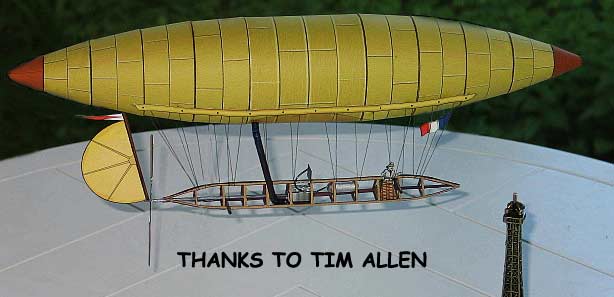 |
|
Santos-Dumont flying his airship #6 toward the Eiffel Tower in Paris and his medal of honor awarded to him from his native Brazil. He was very proud of this. |
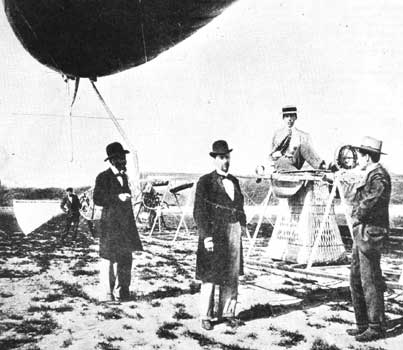 Rare photo of Santos-Dumont posing on the ground along with a few other posers. Notice it looks like Santos is standing on the framework(or sumptin') to look taller |
Specifications for the Santos-Dumont No.6 Airship
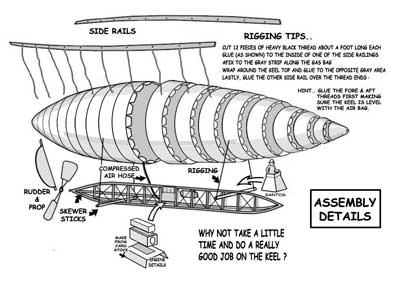 |
Length: 108.3 ft |



